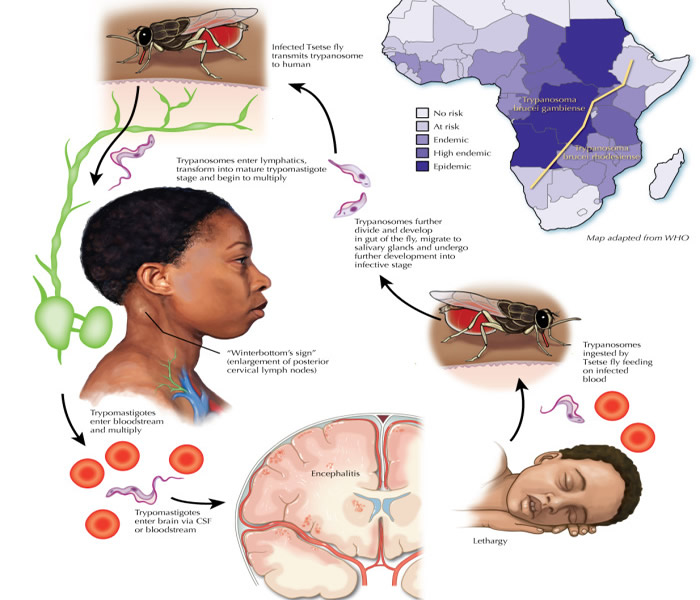Sleeping sickness

Sleeping sickness
African Trypanosomiasis, also known as "sleeping sickness,"is a parasitic infection caused by germs carried by tsetse flies. Tsetse flies are found in 36 countries in sub-Saharan Africa, putting 65 million people at risk. The infection attacks the central nervous system, it results in swelling of the brain. Without treatment the disease is fatal.
Causes
Sleeping sickness is caused byTrypanosoma brucei rhodesiense and Trypanosomoa brucei gambiense. T. b. rhodesiense causes the more severe form of the illness. Tsetse flies carry the infection. When an infected fly bites you, the infection spreads through your blood.
Risk factors include living in parts of Africa where the disease is found and being bitten by tsetse flies. Symptoms
Initially, in the first stage of the disease, there are fevers, headaches, itchiness, and joint pains.
This begins one to three weeks after the bite.
General symptoms include:
- Anxiety
- Mood changes
- Fever
- Headache
- Weakness
- Insomnia at night
- Sleepiness during the day (may be uncontrollable)
- Sweating
- Swollen lymph nodes all over the body
- Swollen, red, painful nodule at site of the fly bite
Diagnosing sleeping sickness before the second stage of the disease is difficult due to the non-specific symptoms of the early stage. Disease management is made in 3 steps:
- Screening for potential infection. This involves using serological tests (only available for T.b.gambiense) and checking for clinical signs - especially swollen cervical lymph nodes.
- Diagnosing by establishing whether the parasite is present in body fluids.
- Staging to determine the state of disease progression. This entails examining the cerebrospinal fluid obtained by lumbar puncture.
- Blood smear
- Cerebrospinal fluid tests (fluid from your spinal cord)
- Complete blood count (CBC)
- Lymph node aspiration
The type of treatment depends on the stage of the disease.
Drugs used in the first stage of the disease are of lower toxicity and are easier to administer. However, treatment success in the second stage of the disease depends on a drug that can cross the blood-brain barrier.
Drugs used in first stage treatment:
- Pentamidine (for T. b. gambiense only)
- Suramin (Antrypol)
- Eflornithine (for T. b. gambiense only)
- Melarsoprol
- Nifurtimox

Outlook (Prognosis)
Without treatment, death can occur within 6 months from cardiac failure or from T. b. rhodesiense infection itself.
T. b. gambiense infection causes sleeping sickness disease and gets worse quickly, often over a few weeks. The disease needs to be treated immediately. Complications
Complications include:
- Injury related to falling asleep while driving or during other activities
- Gradual damage to the nervous system
- Uncontrollable sleep as the disease gets worse
- Coma
See your health care provider right away if you have symptoms. It is important to begin treatment as soon as possible.
Prevention
Pentamidine injections protect against T. b. gambiense, but not against T. b. rhodesiense. Because this medicine is toxic, using it for prevention is not recommended.
Insect control measures can help prevent the spread of sleeping sickness in high-risk areas.




